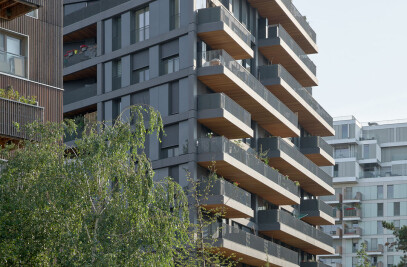Located on the edge of the Saclay Plateau and the Bièvre Valley, the HEC campus has a privileged location. The 138-hectare park features prestigious sports facilities, a vast forest area and a plateau inhabited by buildings from 1962 and designed by the architect René Coulon. Martin Duplantier first delivered the MBA building with David Chipperfield in 2012, on the edge of the forest, opposite the farm fields on the Saclay plateau.
By renovating and densifying the residential park, the office worked on the heart of the cam-pus and its modernist DNA: buildings on stilts, oriented east-west, floating in the trees and free from any vis-à-vis.
The new housing revisits these founding ingredients while giving them a new modernity.
The project presents a heritage approach with an innovative vision of the campus.
New Buildings
It is a question of integrating and reinterpreting the particularities of the original buildings, coming to establish themselves in a system already in place.
Loggias, piles and porosity of the ground floor are all qualities to highlight, which we decided to take inspiration in the design of the new building, the intervention of rehabilitation tying on its side to preserve them.
The new buildings are projected on 4 floors with piles, oriented parallel to the existing ones. The ground floor is left unoccupied.
The residences are all equipped with loggias, taking again the theme of the existing, while offering rooms the intrinsic qualities of this space.
The single rooms are made up of a living space of 16.5 sqm and a loggia 1m deep.
The PMR rooms occupy two frames and are suitable for conversion into T1 as well as T2.
A removable partition system makes it possible to separate the bedroom from the living room. The T2s occupy the south end of the building and thus benefit from a triple orientation.
The opening of the common room occupied by the kitchen makes it possible to animate the gables, as well as the spinning balcony, which makes it possible to break with the bi-oriented system of a typical typology of bar.
The structure, unlike existing buildings, is made of beam poles to ensure maximum flexibility. As typologies are changed, various rooms can be set up at little cost.
The façade matrix represents the best answer to a possible evolution of these typologies.

































